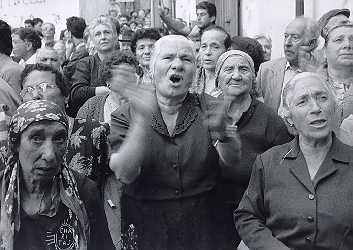
4. Nuptial rite and the cultivation of cereals
The function assumed by the tambourine as a symbol of the female belly is therefore very obvious, both in terms of its physical properties and its sound. The presence of the instrument marks all the parts of the nuptial ceremony that are centred on the bride: the lament, the dancing, the procession that accompanies the bride to the husband's house, the presentation of the gifts, the exhibiting of the sheets. The instrument, played during the weeping of the bride, is the hymen breached, and reveals its symbolic role particularly during the weeping ceremony, in which "the process that is going to take place in real life, i.e., the loss of virginity, is anticipated in a symbolic, dehistoricised, and dream-like form," as De Martino has written (1975: 367), or, as the Roma put it, "the bride weeps in her father's house in order not to weep in her groom's."
The ceremonial tambourine, painted in red and decorated with flowers, becomes the symbolic representation of the fertilised belly of the bride (16).
It will be kept out of sight, because to expose it amounts to display in public the bride's intimate parts. Moreover, other symbolic elements present at the wedding allude to this fertility: among these, the shower of sweets, the eating of bread, salt, and sugar, the dance of the bread, the dance of the apron, the ceremony with honey, the baton decorated with ribbons that accompanies the bride upon her arrival into the bridegroom's village.
The relationship between the wedding festivities and the celebrations of the new seasons is clearly established by this symbolism, and it is strongly felt by the Khorakhané. Likewise, in their eyes, the link between the fertility of the earth and that of the new bride is also highly evident, each recalling the other in both a direct and an indirect way. Thus, the bread is broken and eaten while dancing, so that the grain may grow high and, like the grain that grows from the earth, the bride may have many children. There is an obvious relationship, for the Khorakhané, between the wedding and seasonal festivity, and, by extension, between the wedding and sacred ceremonies that guarantee the fertilising of the earth and the harvest. This relationship is, like the lament, a characteristic of rites of weddings and of death. As Ernesto De Martino has written (1975: 237), "in the religious civilisations of the ancient world the cultural centre of the experience of death does not lie in the experience of the survivor in front of the beloved, but it is in an organic relationship with the alternation of death and revival, in which man had learned to become the provider of death following a human rule, thus effectively inaugurating a separation from natural conditions: that is to say, the alternation of death and the revival of cultivated plants"
The vital and conscious link between wedding and seasonal feast among the Khorakhané does not concern an ancient world of which we only have an indirect experience, but present reality. The relationship between rite and myth is strongly perceived by the community (and in a special way, of course, by the few specialised interpreters); the complex symbolic apparatuses used in the nuptial ceremonies are not obscure remnants of a past now only observable through pieces and relics of a world which was once more organic, dragged passively through history, but coherent elements of a tradition which is firmly rooted in the present. In order to preserve themselves from extinction through homogenisation, the Roma have preserved a role that has belonged to them since their remote Indian past, becoming the craftsmen, the keepers and the specialised interpreters of the societies in which they live. In these societies, the elaboration and the transmission of knowledge beyond their geographical and social horizons normally takes place either through the Gypsies, or through other specialised casts of ambulant and people: soldiers, merchants, touts, carters, and street players. It seems to me that the study of their traditions, not least the musical ones (a study which remains to a large extent still to be carried out), constitutes an unavoidable but fascinating tangle in the warp and weft of Mediterranean and modern European culture.

Peasants and Roma at the Ss.Cosma e Damiano feast in Riace, Cosenza - Photo N. Staiti
In this context, I would like to argue that the strong awareness amongst the Khorakhané concerning the symbols present in the rites, as well as their connections with seasonal feasts, is highly relevant. It is quite remarkable that a group that defines its own identity in terms of similarities and differences with other groups, and that points out in the first place that its difference from the Albanian Gaje lies precisely in its distance from what they see as 'peasant culture', should pay symbolic attention to the growth of the grain and establish an emphatic relationship between the cultivation of cereals and the fertility of the bride. Perhaps the only coherent explanation for these apparent anomalies is to view the Roma as specialised performers of rituals within broader communities which share the same beliefs. The control of the cycle of crop cultivation is divided between two different types of cultural competence: the peasants look after the sowing and harvesting, while the Roma guarantee the success of these operations by keeping alive the awareness of the relationship between the marriage of two human beings and the nuptial rite between man and the earth, by performing the dance of the bread, and by transmitting its ritual significance.
Forward | Back | Rom main page | References